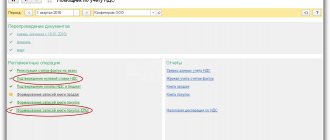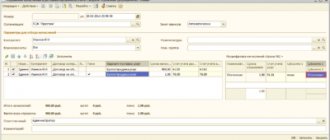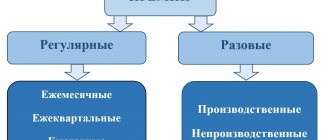Formation of the cost of goods
The concept of the cost of goods for “simplified people” in Chapter.
26.2 of the Tax Code of the Russian Federation is not disclosed. Also in ch. 26.2 there are no references to Ch. 25 of the Tax Code of the Russian Federation, which defines the rules for determining the cost of goods (Article 320 of the Tax Code of the Russian Federation). The cost of goods is formed based on their price paid to the supplier according to the contract. Other expenses incurred by the buyer during acquisition and sale are not included in the cost of goods and are written off separately.
In addition, the VAT paid to the seller should be deducted from the cost of goods (price of goods), since the tax is written off on the basis of sub-clause. 8, 23 clause 1 art. 346.16 of the Tax Code of the Russian Federation is carried out under a separate expense item. The amount of VAT paid is shown in a separate line of the Book of Income and Expenses (letter of the Ministry of Finance of Russia dated January 18, 2010 No. 03-11-11/03, dated December 2, 2009 No. 03-11-06/2/256).
Read more about accounting for “input” VAT on purchased goods in the article “We take into account VAT in expenses - special conditions.”
The cost of goods is recognized as an expense subject to payment for them with the supplier and only after they are sold to the buyer. There is no need to wait to receive payment from the buyer.
Check whether you are correctly writing off purchased goods and taking into account VAT on them, using a Ready-made solution from ConsultantPlus. If you do not have access to the K+ system, get a trial demo access for free.
Write-off from purchased goods
And, despite the fact that the simplified tax system for expenses uses the cash method, receiving and paying them to the supplier is not yet enough to recognize expenses. When will this happen? Often the purchase of goods necessitates their delivery. It can be carried out by the supplier, the buyer or with the help of a third party.
If delivery is carried out by the supplier, then the procedure for writing off such expenses depends on the execution of the purchase agreement: - the cost of delivery can be immediately included in the purchase price of the goods, and not separately allocated.
The procedure for writing off as expenses the cost of purchased goods for resale under the simplified tax system “income minus expenses.”
The required criterion is that they have been implemented, or it is enough that they have been received and paid for.
To write off as expenses purchases purchased for resale, three conditions must be met simultaneously: delivered, paid to the supplier and sold to the buyer.
How to write off the cost of purchased goods sold
The FIFO method is based on the assumption that they are sold over a certain period in the sequence of their acquisition. That is, the goods sold first must be valued at the cost of identical goods that were purchased first.
At the same time, take into account those goods that are on the balance sheet at the beginning of this period.
If the quantity in the first batch is less than the number sold, then write off the goods from the second batch, etc.
Simplified tax system: accounting for expenses for the purchase of goods for resale
We are engaged in the resale of goods, while we are on a simplified taxation system. Goods are purchased externally and sold.
How can a simplifier take into account the costs of goods purchased for resale?
What is the procedure for writing off duties on imported goods purchased for resale? The Tax Code of the Russian Federation establishes that companies and individual entrepreneurs working on a simplified basis with the object “income minus expenses” take into account their expenses after their actual payment.
How to write off the cost of purchased goods purchased for resale, when simplified
Organizations that apply the simplification and pay a single tax on the difference between income and expenses can include in expenses the cost of paid purchases (subclause.
23 clause 1 art. 346.16 Tax Code of the Russian Federation). Chapter 26.2 of the Tax Code of the Russian Federation establishes its own rules for recognizing such costs (subclause 23, clause 1, article 346.16, subclause 2, clause.
2 tbsp. 346.17 Tax Code of the Russian Federation). Therefore, when writing off the cost of purchases, you should not be guided by the provisions of Article 268 of the Tax Code of the Russian Federation (clause
2 tbsp. 346.16 Tax Code of the Russian Federation)
Berator Week “STS in Practice”
reflected in tax accounting at actual cost. Actual cost is the sum of all costs associated with the acquisition.
- amounts paid to the seller (excluding VAT);
- non-refundable taxes paid in connection with the acquisition;
- costs of transporting goods to the company's warehouse.
Please note: input VAT can be included in expenses only by writing off these
USNO: we calculate the cost of goods sold
Finally, the uncertainty regarding the completion and deadline for submitting documents to confirm the main type of activity for “injury” contributions for 2021 has been eliminated. We received comprehensive explanations from the FSS Professional Risk Insurance Department.
All companies and individual entrepreneurs need to submit some kind of statistical reporting. And there are so many forms of this reporting that it’s not surprising to get confused in them.
Register for recording the cost of goods written off in the reporting period
The register is formed to summarize information about the write-off of purchased goods and to form an indicator of the total value of those written off in the reporting (tax) period in the areas of their use.
Maintaining the Register should make it possible to determine the total cost of written-off goods on a monthly basis and on an accrual basis from the beginning of the tax period to the reporting date separately by the areas of use of the written-off goods.
Account 41 “Goods” is intended to summarize information about the availability and movement of inventory items purchased as goods for sale.
In organizations engaged in industrial and other production activities, account 41 “Goods” is used in cases where any products, materials, products are purchased specifically for sale or when the cost of finished products purchased for assembly is not included in the cost of products sold, but Reimbursable by buyers separately.
Tags: balance, tax, expense, simplified tax system
Methods for writing off the cost of goods as expenses
The Tax Code of the Russian Federation allows you to choose one of the following methods for writing off the costs of paying for purchased goods (subclause 2, clause 2, article 346.17 of the Tax Code of the Russian Federation):
- at the cost of the first in time of acquisition (FIFO);
- average cost;
- unit cost of goods.
NOTE! The LIFO method is excluded from the possible methods used.
The Russian Ministry of Finance allows the establishment of different methods for writing off costs for different groups of goods (Letter dated 01.08.2006 No. 03-03-04/1/616). Despite the fact that the clarifications in the letter concern the valuation of goods when calculating income tax, it can be assumed that even under the simplified tax system it is not prohibited to be guided by these clarifications.
The accounting policy for tax purposes must specify the chosen valuation method, and if there are several of them, then it is necessary to describe the groups of goods for which one or another method is applied.
A sample accounting policy for the simplified tax system “income minus expenses” can be found here.
The Tax Code of the Russian Federation does not stipulate how to apply valuation methods in practice, however, a description of all methods of writing off costs for the purchase of goods is contained in paragraphs 17–19 of the Accounting Regulations “Accounting for inventories” PBU 5/01, approved by order of the Ministry of Finance Russia dated 06/09/2001 No. 44n.
If the taxpayer’s sales volume is small, then he usually does not have problems when using any of these methods. So, for example, it is enough to simply track for each unit of goods whether payment was made to the supplier and whether this product was subsequently sold. These are the two conditions that are necessary for accepting the cost of purchased goods as expenses. When maintaining tax accounting registers, you will need to enter information about the acquisition of goods, their sale, payment to the supplier and receipt of payment from buyers.
With a wide range of products, a large volume of sales and keeping records of sales prices, it is quite difficult for the taxpayer to apply the above methods for valuing goods. For example, retail businesses that issue a cash register receipt for a total amount without detailing it find it difficult to track compliance with the requirements that allow them to include the cost of purchased goods in expenses.
In such a situation, you can calculate the cost of goods to include it in expenses using a special formula proposed by the Ministry of Finance of Russia in its letter dated April 28, 2006 No. 03-11-04/2/94. Initially, the clarifications concerned the transition period of 2006, but even now they have not lost their relevance.
Crimea and Sevastopol
In addition to goods purchased during the period of application of the simplified tax regime, organizations of the Republic of Crimea and the city of Sevastopol, which were re-registered under Russian legislation, can take into account other goods when calculating the single tax. Namely, goods purchased for resale in those periods when information about the organization had not yet been entered into the Unified State Register of Legal Entities. But for this the following conditions must be met:
the organization applies a simplified taxation system with the object of taxation “income minus expenses”;
the cost of goods was not previously taken into account for tax purposes (including in those periods when information about the organization was not entered into the Unified State Register of Legal Entities);
the cost of goods is confirmed by the results of the inventory carried out as of January 1, 2015;
goods are sold to customers.
Otherwise, when writing off the cost of purchased goods as expenses, Crimean and Sevastopol organizations must adhere to the general rules.
This is stated in subclause 2.1 of clause 2 of Article 346.17 of the Tax Code of the Russian Federation.
Expenses associated with the purchase of goods
Distribute the costs associated with the purchase of goods according to the appropriate cost items that are provided for organizations using the simplified procedure. For example, include intermediary fees as expenses in accordance with subparagraph 24 of paragraph 1 of Article 346.16 of the Tax Code of the Russian Federation.
Situation: how to take into account the costs of delivering purchased goods to the organization’s warehouse? The organization applies the simplification and pays a single tax on the difference between income and expenses
The answer to this question depends on how the contract for the purchase of goods is drawn up.
Delivery costs may be included in the price of goods, or may be allocated separately.
If delivery costs are specified separately in the contract, then after payment for these services they can be taken into account when calculating the single tax (clause 2 of Article 346.17 of the Tax Code of the Russian Federation). This applies to both the cost of transport services from third-party organizations and the cost of delivery using our own transport. Costs for delivery of goods can be included either in material costs (subclause 5, clause 1, article 346.16, subclause 6, clause 1, article 254 of the Tax Code of the Russian Federation), or in the costs associated with their acquisition (subclause 23 clause 1 Article 346.16 of the Tax Code of the Russian Federation). An organization has the right to determine a specific expense item independently in its accounting policy for tax purposes. Similar clarifications are contained in the letter of the Ministry of Finance of Russia dated September 8, 2011 No. 03-11-06/2/124.
If delivery costs are included in the price of goods, their amount will reduce the tax base for the single tax in the period in which the organization writes off the cost of purchased goods (subclause 2, clause 2, article 346.17 of the Tax Code of the Russian Federation). This is due to the fact that when calculating the single tax, the cost of purchased goods can only be taken into account if three conditions are simultaneously met. Typically, these conditions are met after payment of shipping costs. Therefore, when concluding an agreement with a supplier, it is advisable not to include the cost of delivery in the price of the purchased goods.
FIFO method
When using the FIFO method, expenses take into account the cost of those goods that were purchased earlier than others. When purchasing goods in batches, it is first necessary to write off goods from the first received batch, if it is insufficient - from the second, etc. in order.
This method is convenient to use for writing off the cost of goods whose prices decrease over time, or for the subsequent provision of cumulative discounts by sellers. After all, first of all, expenses take into account the cost of goods purchased at the highest price.
Example
Sever LLC is engaged in the resale of refrigerators. On September 5, the company purchased and paid for the first batch of 8 Atlant refrigerators at a price of RUB 8,500.00. per piece (without VAT). On September 15, the second batch of 12 such refrigerators was received and paid for at a price of RUB 8,300.00. per piece (without VAT). In total, Sever LLC sold 14 refrigerators in September.
The accountant of Sever LLC needs to write off the costs of purchasing refrigerators as follows:
- 8 refrigerators for the price of RUB 8,500.00. from the first batch – 68,000.00 rubles;
- 6 refrigerators for the price of RUB 8,300.00. from the second batch – RUB 49,800.00.
It turns out that in September the expenses will take into account:
RUB 68,000.00 + 49,800.00 rub. = 117,800.00 rub.
Write-off method based on the cost of each unit
The method is quite simple, since each unit of goods is written off as expenses at the cost of its acquisition.
The write-off method based on the cost of each unit is suitable for those organizations that trade unique single products or with a small range of products.
Example
Volga LLC is engaged in the trade of gas equipment and keeps records of goods at the cost of each unit. Under the supply agreement, in February the organization purchased and paid for a universal boiler that runs on solid and liquid fuels at a cost of 120,000 rubles. In March, the boiler is sold by the Kama organization for 158,000 rubles, which immediately pays for this equipment. This means that Volga’s expenses for September should take into account the cost of purchasing a boiler in the amount of 120,000 rubles.
Average cost write-off method
The average cost write-off method is used for one type or one group of goods. In this case, the cost of goods written off as expenses is determined in 2 stages.
First of all, it is necessary to calculate the average cost of the type of goods purchased for subsequent sale; for this, the total cost of goods available in the warehouse at the beginning of the month and received during the month is divided by the number of these goods available in the balance at the beginning and received during the month. Only those goods for which payments were made to suppliers are taken for calculation.
| Average unit cost | = | Cost of inventory balances at the beginning + cost of goods received | / | Number of goods at the beginning of the month + number of goods received |
At the second stage, the cost of goods sold is calculated, which can be included in expenses.
| Price goods included in expenses | = | Quantity implemented goods | X | average cost units goods |
Example
In November, Gaz-M LLC purchased three lots of gas meters SGBM-1.6, SGBM-2.5, SGBM-3.2 for resale to the public:
- batch SGBM-1.6 - 60 meters at a price of 1,200 rubles. per piece (without VAT);
- batch SGBM-2.5 – 120 meters at a price of 1,280 rubles. per piece (without VAT);
- batch SGBM-3.2 - 80 meters at a price of 1,320 rubles. per piece (without VAT);
Payment was made to the supplier in the same month.
As of 01.11, Gaz-M had 35 meters in its warehouse in the amount of 41,700.00 rubles.
During November, 180 meters of various prices were sold.
The accounting policy of Gaz-M LLC establishes a method for writing off the cost of goods as expenses based on the average cost of a group of goods.
We need to determine the cost of goods that needs to be written off as expenses for November.
Let's calculate:
- cost of goods received:
60 pcs. × 1,200 rub. + 120 pcs. × 1,280 rub. + 80 pcs. × 1,320 rub. = 331,200 rub.;
- cost of received meters taking into account the balance at the beginning of the month:
RUB 41,700 + 331,200 rub. = 372,900 rub.;
- total number of meters received, taking into account the balance at the beginning of the month:
35 pcs. + 60 pcs. + 120 pcs. + 80 pcs. = 295 pcs.
Thus, the average cost per unit of goods was equal to:
RUB 372,900 / 295 pcs. = 1264 rub.
Based on the average cost per unit of goods, the accountant will determine the amount of expenses that he will take into account in November:
180 pcs. × 1264 rub. = 227,520 rub.
See also “Methods for estimating inventories”.
Results
To recognize the cost of purchased goods as expenses under the simplified tax system, several conditions must be met: the organization applies the taxation object “income minus expenses”, the goods are paid to the supplier and sold to the buyer.
If these conditions are met, the cost of purchased goods sold is determined by one of the methods specified in the organization’s accounting policies. You can find more complete information on the topic in ConsultantPlus. Free trial access to the system for 2 days.
Timely entry of expenses for the purchase of goods into KUDiR
- home
- About company
- Articles
- Consultation line
- Timely entry of expenses for the purchase of goods into KUDiR
August 24, 2020
Customer question:
Simplified taxation system, Income minus Expenses, 15%. What needs to be done to ensure that expenses for the purchase of goods are included in KUDiR in a timely manner?
Answer from the consultation line specialist:
We check the procedure for recognizing expenses for the purchase of goods: Main -> Taxes and reports -> simplified tax system.
The setting determines at what stage the expense will be recognized. Mandatory conditions are the receipt, payment and sale of goods, so these checkboxes are not disabled. The last checkbox is checked if we want to recognize expenses for the purchase of goods only after receiving payment from the buyer for the goods sold. We will not consider this option; we will limit ourselves to the basic requirements.
The order in which transactions are reflected does not matter. An expense is recognized when the third transaction is completed, subject to the completion of the other two. The only restriction: implementation cannot be earlier than receipt. The wording of the contents of the KUDiR record depends on which operation was the final one.
When using the simplified tax system of 15%, when writing off the cost of inventories, the FIFO method is always used, this implies batch accounting.
When posting the document Receipt (act, invoice) on the debit of account 41.01 (Goods in warehouses), there will always be three sub-accounts: item, warehouse, batch. The batch is the receipt document itself. It is also an analytics on account 60.01 (Settlements with suppliers and contractors), where the fact of payment to the supplier is tracked.
When selling goods, under loan 41.01, the nomenclature, warehouse, and batch are also registered. The specified details must correspond to the receipt document.
If the batch and amount remain blank, check the availability of: balance sheet for the account, in the grouping we include all the checkboxes (items, warehouses, batches), on the “Selection” tab you can set a filter by the item item of interest.
The fact of payment to the supplier is registered with the document Write-off from the current account, if through the cash register - an expense cash order. While moving, we check the document used to make the payment:
An entry in the Income and Expense Book is generated.
You can check it in the section Reports -> Simplified tax system -> Book of income and expenses of the simplified tax system.
Another option: first we pay, then we sell.
In this case, an entry in the book of income and expenses is formed in the sales document
Recommendation: track the batches on the inventory accounts (10, 41), and the same batches on account 60.01.
If, for some reason, settlements with the supplier do not fall as expected (remains from previous periods, contracts are mixed up, etc.), you can use a tool for managing the offset of advances and repayment of debt. It is also included in all documents relating to mutual settlements with counterparties.
Set the debt repayment method “By document”, select the document.






